Austevoll Seafood Bundle
Can Austevoll Seafood Continue to Thrive in the Global Seafood Market?
Dive into the strategic world of Austevoll Seafood, a leading Austevoll Seafood SWOT Analysis reveals the company's ambitious growth strategy, shaped by decades of experience in the fishing industry and a commitment to sustainable practices. Established in 1981, this Norwegian seafood company has evolved from a local player into a global powerhouse, navigating the complexities of aquaculture and the broader seafood market.
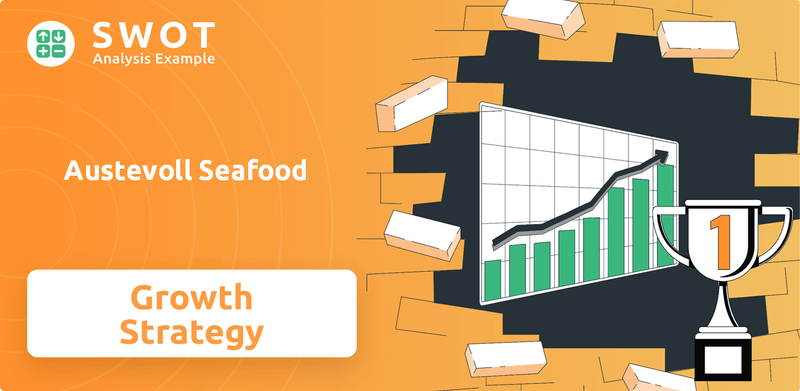
This analysis explores the future prospects of Austevoll Seafood, examining its expansion plans, innovations, and strategic initiatives. We'll delve into how Austevoll Seafood aims to maintain its competitive advantages, including its sustainability initiatives and its ability to adapt to changing market dynamics. Discover how Austevoll Seafood's financial performance review and long-term growth potential position it within the global seafood market, making it a compelling case study for investors and business strategists alike.
How Is Austevoll Seafood Expanding Its Reach?
The Austevoll Seafood company's growth strategy is heavily focused on expansion, both geographically and in terms of the products it offers. This approach includes strategic acquisitions and mergers, allowing the company to broaden its presence in the aquaculture and fishing industry. The company's strategy is designed to capitalize on opportunities and navigate the complexities of the global seafood market.
Austevoll Seafood actively seeks out and integrates complementary businesses to strengthen its portfolio. This strategy is evident in its history of acquiring significant stakes in key players like the Leroy Seafood Group and Kobbevik og Furuholmen Oppdrett. The acquisition of Vik Settefisk on June 15, 2023, is a recent example of this approach, showcasing the company's commitment to growth through strategic investments.
The company's expansion initiatives are supported by its robust operational infrastructure, including 23 fishing vessels and 35 processing plants. This infrastructure enables Austevoll Seafood to handle a substantial volume of raw materials, ranging from 1.6 to 2.0 million metric tons annually, ensuring a strong foundation for its growth plans. For more information about the company's ownership structure, you can refer to Owners & Shareholders of Austevoll Seafood.
Austevoll Seafood operates across multiple regions, with a significant presence in Peru. The company is also expanding its reach in Chile. These geographical expansions are supported by strategic investments in infrastructure and operations.
The company diversifies its product offerings to include various seafood species. This diversification helps mitigate risks associated with fluctuations in specific markets. The company also focuses on increasing its volumes of salmon and trout.
Austevoll Seafood actively pursues mergers and acquisitions to expand its business. The acquisition of Vik Settefisk in 2023 is a prime example. These strategic moves enable the company to strengthen its market position and integrate new technologies.
The company forms strategic partnerships to enhance its operational capabilities. These partnerships are crucial for accessing new markets and improving supply chain efficiencies. Strategic alliances support the company's long-term growth objectives.
Geographically, Austevoll Seafood shows strong performance in Peru, with the quota for the Centre/North region increasing to 3.0 million metric tons in 2025, up from 2.47 million metric tons in 2024. FoodCorp Chile S.A. also achieved record catches of Jack mackerel in Q1 2025, benefiting from a 25% increase in the SPRFMO's global quota for 2025. The company's own catch volumes for Jack Mackerel and other species in Q1 2025 reached 55,000 metric tons, with projections for a total catch of 557,000 metric tons in 2025 for its Peruvian operations. Despite challenges in the wild catch segment, the company projects its total group volume to reach 211.0 thousand tonnes in 2025, up from 171.1 thousand tonnes in 2019. Furthermore, Lerøy's farming volumes are expected to grow steadily, with total Norway volumes projected to increase from 158.2 thousand tonnes in 2019 to 195.0 thousand tonnes in 2025. The company expects its salmon/trout volume to increase significantly from 44,000 GWT to 219,000 GWT in 2025.
Austevoll Seafood is focused on increasing its production capacity and market reach through strategic initiatives. These initiatives are designed to drive revenue growth and enhance shareholder value.
- Increased quotas in key regions, such as Peru.
- Growth in farming volumes, particularly salmon and trout.
- Strategic acquisitions to expand the company's portfolio.
- Focus on sustainable practices to ensure long-term growth.
Austevoll Seafood SWOT Analysis
- Complete SWOT Breakdown
- Fully Customizable
- Editable in Excel & Word
- Professional Formatting
- Investor-Ready Format
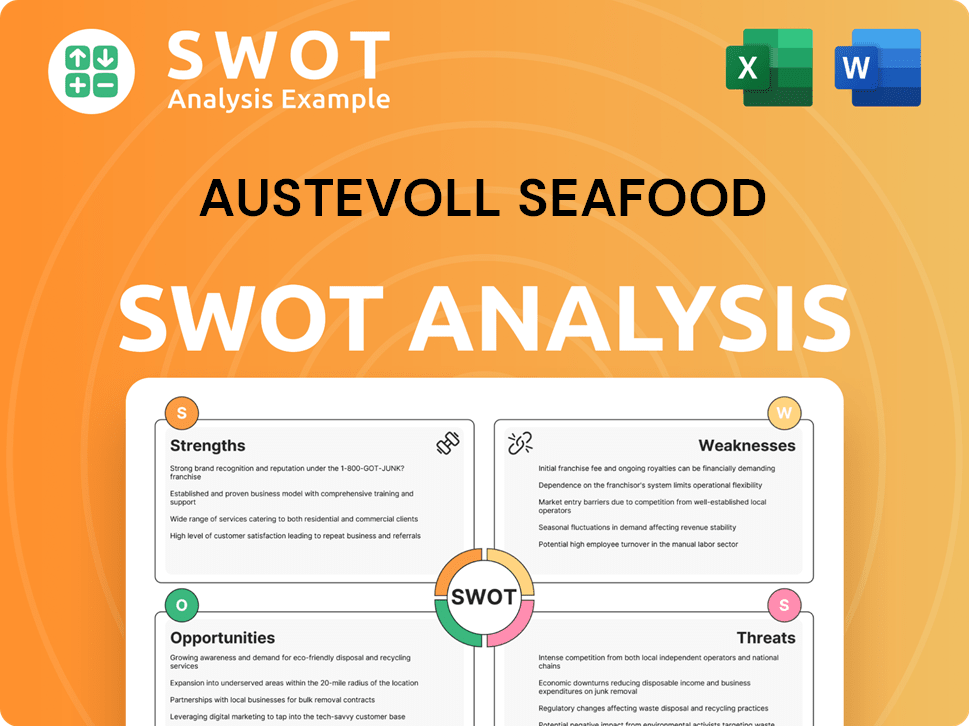
How Does Austevoll Seafood Invest in Innovation?
The Austevoll Seafood's growth strategy heavily relies on technological advancements and innovation, particularly within its aquaculture and processing operations. This approach aims to improve efficiency, reduce costs, and enhance sustainability. The company is focused on improving biological performance in salmon farming, which is crucial for increasing harvest volumes and reducing operational expenses.
One of the key areas of focus is improving biological performance in salmon farming. This involves implementing projects and actions designed to reduce mortality rates, increase growth speed, and achieve targeted harvest volumes. The company expects significant cost reductions in 2025 due to higher harvest volumes resulting from these improvements.
Additionally, the company is integrating shielding technology to improve fish health and survival rates. The proportion of fish harvested from sites using shielding technology is expected to gradually increase through 2025, reflecting the positive experiences reported with this technology. These strategies are part of a broader effort to ensure the company's long-term growth potential.
The company is actively working to enhance biological performance in salmon farming. This includes reducing mortality rates and increasing growth speed. These improvements are expected to lead to higher harvest volumes and cost reductions in 2025.
Shielding technology is being implemented to improve fish health and survival. The use of this technology is expected to increase gradually through 2025. Positive experiences with shielding technology support its continued deployment.
Subsidiaries are focused on enhancing production efficiencies. For example, significant improvements in biological development have been achieved. This has led to record-breaking production levels in Q4 2024.
The company is taking a structured approach to increase profitability in its Value Added Products, Sales & Distribution (VAPS&D) segment. This involves better utilization of processing capacity. Improvements are being made across the industrial structure.
The company emphasizes a greater focus on climate risk and sustainable practices. This includes integrating these considerations into its operations. The goal is to reduce total Scope 1, 2, and 3 emissions by 46% by 2030 from a 2019 base year.
Ongoing efforts to improve biological performance and implement shielding technology demonstrate a commitment to technological advancements. Optimizing processing capacity is also a key focus. These efforts support the company's growth.
The company's subsidiaries, such as Lerøy Seafood Group, are also contributing to these advancements. Lerøy has seen significant improvements in biological development, leading to the highest Q4 sea-based production in the company's history in 2024. Furthermore, the company is focused on increasing profitability in its Value Added Products, Sales & Distribution (VAPS&D) segment by improving the utilization of its processing capacity in Norway and its national and international industrial structure. The company's commitment to sustainability is also evident through its initiatives to reduce emissions. For more insights into the company's target market, consider reading about the Target Market of Austevoll Seafood.
The company's strategy involves several key initiatives aimed at driving growth and efficiency. These include improving biological performance, implementing shielding technology, and optimizing processing capacity.
- Focus on improving biological performance in salmon farming to reduce mortality and increase growth.
- Gradual increase in the proportion of fish harvested from sites using shielding technology.
- Enhancing production efficiencies through subsidiaries, such as Lerøy Seafood Group.
- Structured approach to increase profitability in the VAPS&D segment.
- Emphasis on climate risk and sustainable practices, aiming to reduce emissions.
Austevoll Seafood PESTLE Analysis
- Covers All 6 PESTLE Categories
- No Research Needed – Save Hours of Work
- Built by Experts, Trusted by Consultants
- Instant Download, Ready to Use
- 100% Editable, Fully Customizable
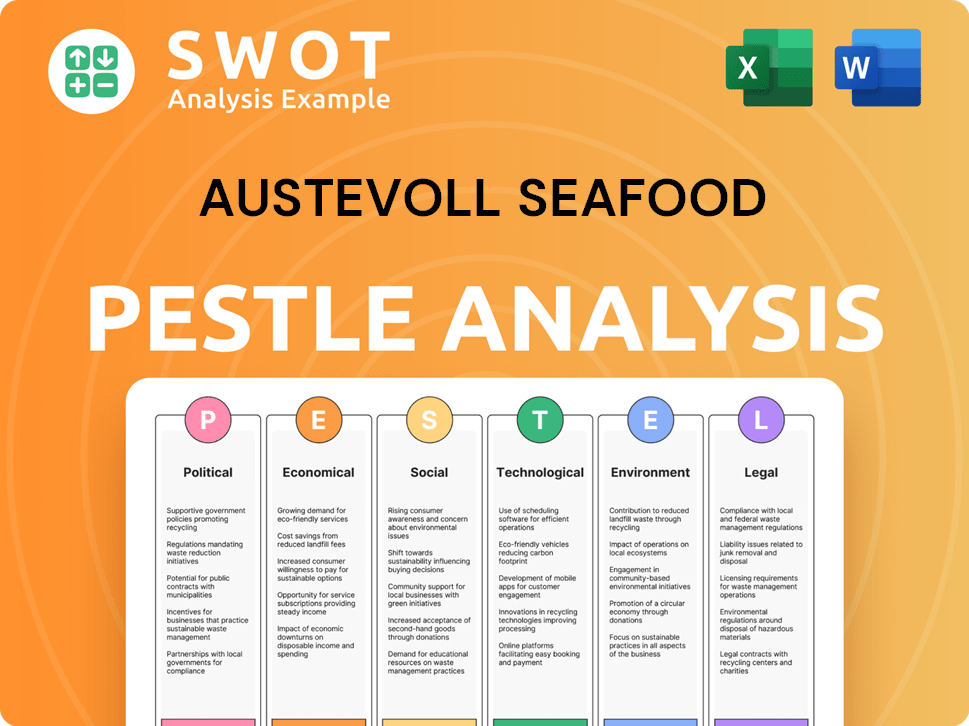
What Is Austevoll Seafood’s Growth Forecast?
The financial outlook for Austevoll Seafood reflects robust performance and strategic growth initiatives. The company's focus on sustainable practices and market expansion is expected to drive future value. This analysis provides a detailed review of the financial results, market position, and future prospects of the company.
In Q1 2025, Austevoll Seafood demonstrated strong financial results. This performance underscores the company's ability to capitalize on market opportunities and manage its operations effectively. The strategic decisions made by the company are reflected in its financial achievements.
The company's financial health is further supported by its strong equity position and dividend policy. The company's commitment to shareholder returns, combined with its focus on sustainable practices, positions it well for long-term growth in the competitive seafood market.
Operating revenue for Q1 2025 was NOK 9,793 million, a 17% increase from NOK 8,374 million in Q1 2024. This growth indicates strong sales and effective market strategies. The increase in revenue demonstrates the company's ability to expand its market share and capitalize on opportunities.
Adjusted EBITDA for Q1 2025 reached NOK 1,938 million, up from NOK 1,660 million in Q1 2024. Adjusted EBIT rose to NOK 1,394 million from NOK 1,160 million. These figures highlight improved operational efficiency and profitability.
Despite a negative fair value adjustment of biological assets, profit before tax was NOK 1.258 billion in Q1 2025, a 23% increase year-over-year. Net income for Q1 2025 was NOK 12.0 million, a 97% decrease from Q1 2024. The profit margin decreased to 0.1% from 4.8% in Q1 2024.
As of March 31, 2025, total assets were NOK 53,023 million, with an equity of NOK 29,109 million and an equity ratio of 55%. The trailing 12-month revenue as of March 31, 2025, was $3.37 billion. These figures demonstrate a solid financial foundation.
Revenue is forecast to grow 7.7% per annum on average during the next three years. This growth rate is slightly below the 8.0% growth forecast for the Food industry in Norway. This indicates a strong potential for the company.
The company’s net margin as of May 28, 2025, was 7.76%. This reflects the overall profitability of the business. This shows the company's ability to manage costs and generate profits.
The board has recommended a dividend payment of NOK 6.50 per share for the annual shareholders meeting in 2025, an increase from NOK 4.5 per share last year. The company aims to pay out 20-40% of net profit as dividends.
The average payout ratio over the past 10 years has been 56%, with a median of 33%. This shows the company's commitment to returning value to shareholders. This consistent dividend policy supports investor confidence.
The company's strong financial performance, coupled with its strategic initiatives, positions it well for future growth. The focus on sustainable practices and market expansion will likely drive long-term value creation. The company's strategic direction is well-aligned with industry trends.
The solid financial position and consistent dividend payments make Austevoll Seafood an attractive investment. The company's growth strategy and market position provide a strong foundation for future returns. This makes it a compelling choice for investors.
Austevoll Seafood Business Model Canvas
- Complete 9-Block Business Model Canvas
- Effortlessly Communicate Your Business Strategy
- Investor-Ready BMC Format
- 100% Editable and Customizable
- Clear and Structured Layout
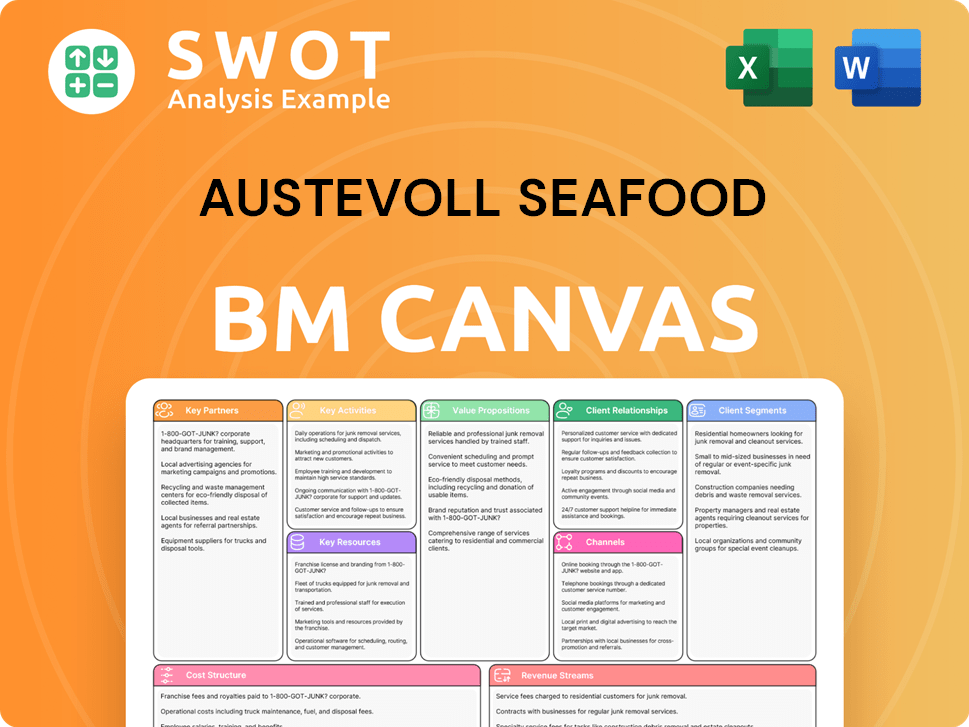
What Risks Could Slow Austevoll Seafood’s Growth?
The Austevoll Seafood faces several strategic and operational risks that could impact its growth strategy. The seafood industry is inherently volatile, primarily due to fluctuating prices driven by changes in supply. This instability presents a significant challenge for the company, affecting its financial performance and future prospects.
Environmental factors and regulatory changes add further complexity. Challenges like disease outbreaks and fluctuating fishing quotas can disrupt operations and impact profitability. The evolving regulatory landscape, including potential tax changes and industry reorganization, adds to the uncertainty facing the company.
Moreover, macroeconomic factors and geopolitical events, such as trade wars and currency fluctuations, contribute to financial risks. These external factors require robust risk management strategies to mitigate their impact on Austevoll Seafood's operations and financial results.
Unstable prices, driven by variable supply, pose a primary risk. Salmon farmers, for example, are often price takers. In Q1 2025, despite higher slaughtered volumes of salmon and trout, spot prices decreased by NOK 19/kg year-over-year. This volatility directly affects the company's revenue and profitability.
Environmental issues and disease outbreaks are ongoing threats. The industry faces costs associated with treating sea lice and winter wounds. These challenges can lead to increased operational expenses and potential disruptions in production, impacting the company's financial performance.
Changes in fishing quotas present a considerable obstacle. While Peru saw an increased anchoveta quota in Q1 2025, the North Atlantic faces significant decreases in quotas for several species. Lower whitefish catch volumes are also expected in 2025 due to reduced quotas, affecting the supply of raw materials.
Regulatory changes can impact the company's profitability. The 'resource rent' tax introduced in Norway on sea-based salmon and trout production can affect the company's capacity to pay dividends. The proposed 'Aquaculture Report' in 2024-2025 may lead to significant industry reorganization.
Political trade barriers and trade wars can affect market access. The introduction of tariffs, as seen with the USA, can influence the company's global market access and financial results. Macroeconomic factors and currency fluctuations also contribute to financial risks, adding to the complexity.
Austevoll Seafood addresses these risks through improved risk management frameworks. This includes an established ESG subcommittee and a detailed description of risk exposure in its annual reports. The company's diversified operations across pelagic fish, whitefish, and salmon, along with its global presence, serve as a form of diversification.
Austevoll Seafood employs robust risk management strategies to navigate these challenges. The company's diversified operations across pelagic fish, whitefish, and salmon, along with its global presence, help to mitigate the impact of localized issues. The company's approach to risk management includes an established ESG subcommittee and detailed risk disclosures in its annual reports. This multifaceted strategy helps to protect the future prospects of the company.
Regulatory changes, such as Norway's 'resource rent' tax, directly impact profitability. The potential reorganization suggested by the 'Aquaculture Report' poses significant challenges. These regulatory shifts require the company to adapt its strategies, potentially affecting its financial performance. For more insights into the company's history and development, you can read the Brief History of Austevoll Seafood.
Austevoll Seafood Porter's Five Forces Analysis
- Covers All 5 Competitive Forces in Detail
- Structured for Consultants, Students, and Founders
- 100% Editable in Microsoft Word & Excel
- Instant Digital Download – Use Immediately
- Compatible with Mac & PC – Fully Unlocked
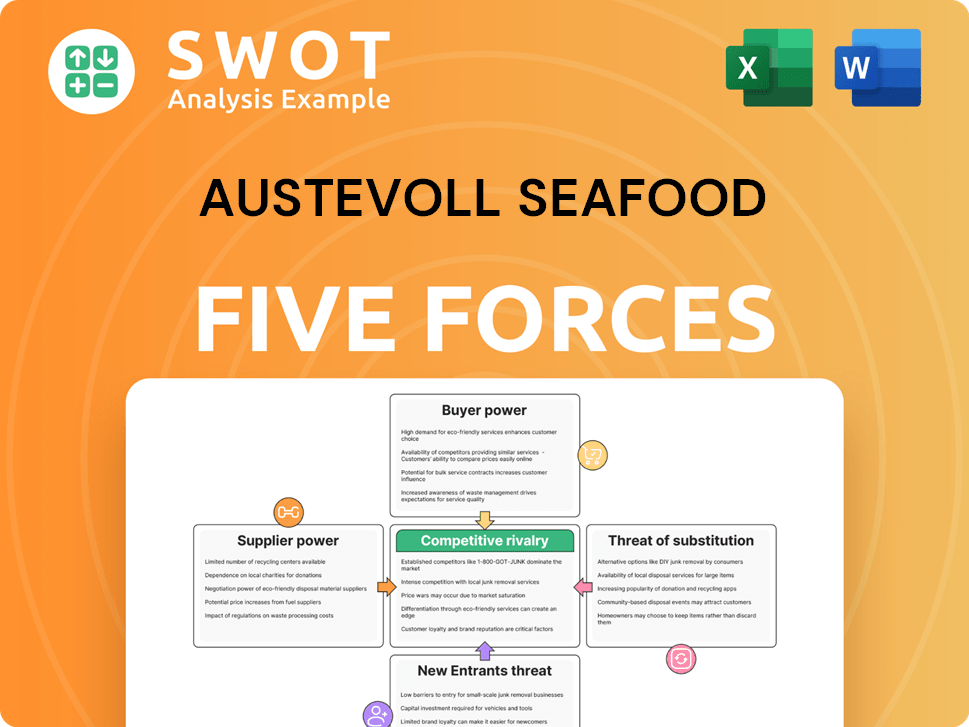
Related Blogs
- What are Mission Vision & Core Values of Austevoll Seafood Company?
- What is Competitive Landscape of Austevoll Seafood Company?
- How Does Austevoll Seafood Company Work?
- What is Sales and Marketing Strategy of Austevoll Seafood Company?
- What is Brief History of Austevoll Seafood Company?
- Who Owns Austevoll Seafood Company?
- What is Customer Demographics and Target Market of Austevoll Seafood Company?
Disclaimer
All information, articles, and product details provided on this website are for general informational and educational purposes only. We do not claim any ownership over, nor do we intend to infringe upon, any trademarks, copyrights, logos, brand names, or other intellectual property mentioned or depicted on this site. Such intellectual property remains the property of its respective owners, and any references here are made solely for identification or informational purposes, without implying any affiliation, endorsement, or partnership.
We make no representations or warranties, express or implied, regarding the accuracy, completeness, or suitability of any content or products presented. Nothing on this website should be construed as legal, tax, investment, financial, medical, or other professional advice. In addition, no part of this site—including articles or product references—constitutes a solicitation, recommendation, endorsement, advertisement, or offer to buy or sell any securities, franchises, or other financial instruments, particularly in jurisdictions where such activity would be unlawful.
All content is of a general nature and may not address the specific circumstances of any individual or entity. It is not a substitute for professional advice or services. Any actions you take based on the information provided here are strictly at your own risk. You accept full responsibility for any decisions or outcomes arising from your use of this website and agree to release us from any liability in connection with your use of, or reliance upon, the content or products found herein.